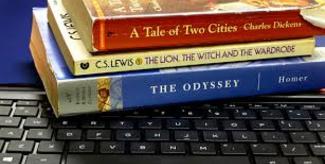English Language Arts

Common Core State Standards for English Language Arts
The Common Core State Standards for English Language Arts & Literacy in History/Social Studies, Science, and Technical Subjects help ensure that all students are literate and college and career ready no later than the end of high school. The Standards set requirements not only for English language arts but also for literacy in history / social studies, science, and technical subjects. Just as students must learn to read, write, speak, listen, and use language effectively in content areas, so too must the Standards specify the literacy skills and understandings required for college and career readiness in multiple disciplines.
Students Who Are College and Career Ready in Reading, Writing, Speaking and Listening, and Language
The descriptions that follow are not standards themselves but instead offer a portrait of students who meet the standards set out in this document and show capabilities of the literate individual.
They Demonstrate Independence. Students can, without significant scaffolding, comprehend and evaluate complex texts across a range of types and disciplines, and they can construct effective arguments and convey intricate or multifaceted information. Likewise, students are independently able to discern a speaker’s key points, request clarification, and ask relevant questions. They build on others’ ideas, articulate their own ideas, and confirm they have been understood.
They Build Strong Content Knowledge. Students establish a base of knowledge across a wide range of subject matter by engaging with works of quality and substance. They become proficient in new areas through research and study. They read purposefully and listen attentively to gain both general knowledge and discipline-specific expertise. They refine and share their knowledge through writing and speaking.
They Respond to the Varying Demands of Audience, Task, Purpose, and Discipline. Students adapt their communication in relation to audience, task, purpose, and discipline. They set and adjust purpose for reading, writing, speaking, listening, and language use as warranted by the task. They appreciate nuances, such as how the composition of an audience should affect tone when speaking and how the connotations of words affect meaning. They also know that different disciplines call for different types of evidence (e.g., documentary evidence in history, experimental evidence in science).
They Comprehend as well as Critique. Students are engaged and open-minded—but discerning—readers and listeners. They work diligently to understand precisely what an author or speaker is saying, but they also question an author’s or speaker’s assumptions and premises and assess the veracity of claims and the soundness of reasoning.
They Value Evidence. Students cite specific evidence when offering an oral or written interpretation of a text. They use relevant evidence when supporting their own points in writing and speaking, making their reasoning clear to the reader or listener, and they constructively evaluate others’ use of evidence.
They use Technology and Digital Media Strategically and Capably. Students employ technology to enhance reading, writing, speaking, listening, and language use. They tailor searches online to acquire useful information efficiently, and they integrate what they learn through technology with what they learn offline. They are familiar with strengths and limitations of technological tools and media and can select and use those best for communication goals.
They come to Understand other Perspectives and Cultures. Students appreciate twenty-first-century classroom and workplaces are settings in which people from divergent cultures and who represent diverse experiences and perspectives must learn and work together. Students actively seek to understand other perspectives and cultures through reading and listening, and are able to communicate effectively with people of varied backgrounds. They evaluate other points of view critically and constructively. Through reading great classic and contemporary works of literature representative of a variety of periods, cultures, and worldviews, students can vicariously inhabit worlds and have experiences much different from their own.
CDE Recommended Literature
Recommended Literature: Prekindergarten Through Grade Twelve is a searchable database of books for children and teens which helps students, teachers, and families find books that entertain, inform, and explore new ideas and experiences. Each book has a description called an "annotation" that explains what the book is about.
Recommended Readings in Literature: Kindergarten Through Grade Eight
Addendum Recommended Readings in Literature: Kindergarten Through Grade Eight
Recommended Readings in Literature: Kindergarten Through Grade Eight
Literature for History-Social Science: Kindergarten Through Grade Eight
Literature for Science and Mathematics: Kindergarten Through Grade Twelve
Literature for Visual and Performing Arts: Kindergarten Through Grade Twelve
6-8 ELA Guides & Resources
6th - 8th Grade English Language Arts/ English Language Development Framework

3 Key Shifts in Common Core ELA Standards
The following are key shifts called for by the Common Core:
-
Regular practice with complex texts and their academic language - Rather than focusing solely on the skills of reading and writing, the ELA/literacy standards highlight the growing complexity of the texts students must read to be ready for the demands of college, career, and life.
-
Reading, writing, and speaking grounded in evidence from texts, both literary and informational - The Common Core emphasizes using evidence from texts to present careful analyses, well-defended claims, and clear information. The standards call for students to answer questions that depend on their having read the texts with care.
-
Building knowledge through content-rich nonfiction -Students must be immersed in information about the world around them if they are to develop the strong general knowledge and vocabulary they need to become successful readers and be prepared for college, career, and life. Informational texts play an important part in building students’ content knowledge. In grades 6-12, there is greater attention on the specific category of literary nonfiction and the standards for literacy in history/social studies, science, and technical subjects ensure that students can independently build knowledge in these disciplines through reading and writing.


